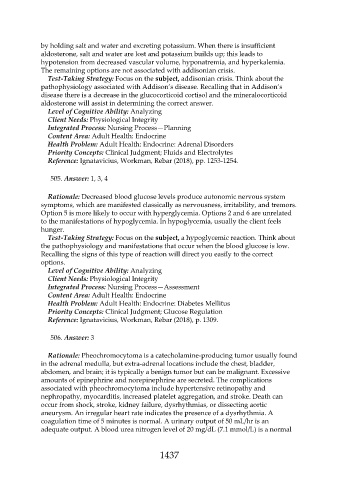Page 1437 - Saunders Comprehensive Review For NCLEX-RN
P. 1437
by holding salt and water and excreting potassium. When there is insufficient
aldosterone, salt and water are lost and potassium builds up; this leads to
hypotension from decreased vascular volume, hyponatremia, and hyperkalemia.
The remaining options are not associated with addisonian crisis.
Test-Taking Strategy: Focus on the subject, addisonian crisis. Think about the
pathophysiology associated with Addison’s disease. Recalling that in Addison’s
disease there is a decrease in the glucocorticoid cortisol and the mineralocorticoid
aldosterone will assist in determining the correct answer.
Level of Cognitive Ability: Analyzing
Client Needs: Physiological Integrity
Integrated Process: Nursing Process—Planning
Content Area: Adult Health: Endocrine
Health Problem: Adult Health: Endocrine: Adrenal Disorders
Priority Concepts: Clinical Judgment; Fluids and Electrolytes
Reference: Ignatavicius, Workman, Rebar (2018), pp. 1253-1254.
505. Answer: 1, 3, 4
Rationale: Decreased blood glucose levels produce autonomic nervous system
symptoms, which are manifested classically as nervousness, irritability, and tremors.
Option 5 is more likely to occur with hyperglycemia. Options 2 and 6 are unrelated
to the manifestations of hypoglycemia. In hypoglycemia, usually the client feels
hunger.
Test-Taking Strategy: Focus on the subject, a hypoglycemic reaction. Think about
the pathophysiology and manifestations that occur when the blood glucose is low.
Recalling the signs of this type of reaction will direct you easily to the correct
options.
Level of Cognitive Ability: Analyzing
Client Needs: Physiological Integrity
Integrated Process: Nursing Process—Assessment
Content Area: Adult Health: Endocrine
Health Problem: Adult Health: Endocrine: Diabetes Mellitus
Priority Concepts: Clinical Judgment; Glucose Regulation
Reference: Ignatavicius, Workman, Rebar (2018), p. 1309.
506. Answer: 3
Rationale: Pheochromocytoma is a catecholamine-producing tumor usually found
in the adrenal medulla, but extra-adrenal locations include the chest, bladder,
abdomen, and brain; it is typically a benign tumor but can be malignant. Excessive
amounts of epinephrine and norepinephrine are secreted. The complications
associated with pheochromocytoma include hypertensive retinopathy and
nephropathy, myocarditis, increased platelet aggregation, and stroke. Death can
occur from shock, stroke, kidney failure, dysrhythmias, or dissecting aortic
aneurysm. An irregular heart rate indicates the presence of a dysrhythmia. A
coagulation time of 5 minutes is normal. A urinary output of 50 mL/hr is an
adequate output. A blood urea nitrogen level of 20 mg/dL (7.1 mmol/L) is a normal
1437

